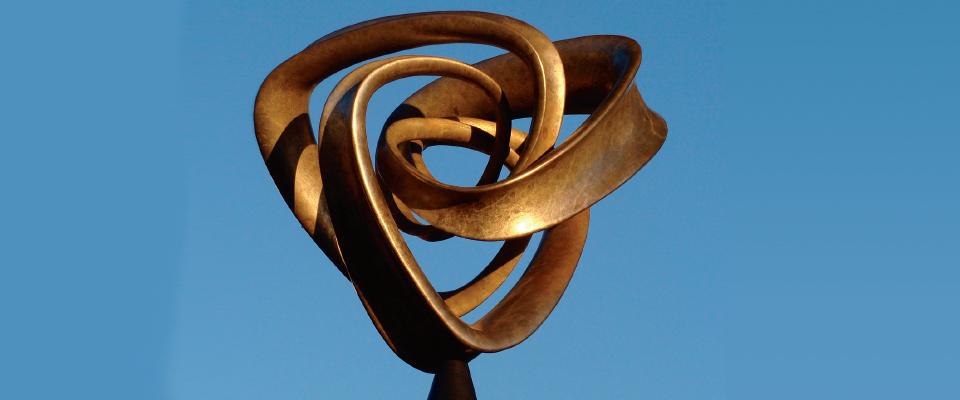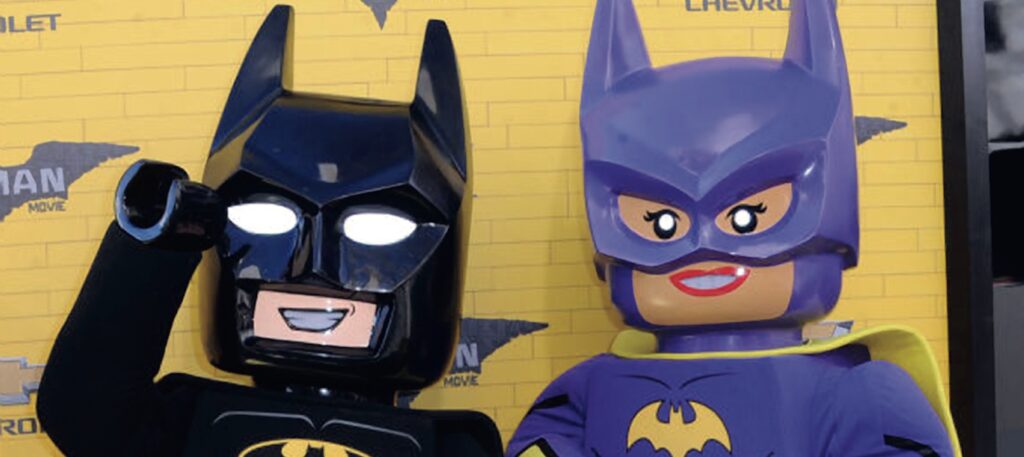The Center for New Media is less concerned with whiz-bang technologies than with old values—truth, depth, reliability, authenticity, aesthetics, and public service.
Early in his academic career, engineering professor Ken Goldberg faced a right-brain/left-brain fork in the road. As a kid growing up in Bethlehem, Pennsylvania, in the 1970s, he loved art. He loved studying art in various forms, he loved creating art in various forms, and he loved losing himself among the treasures in art museums in Philadelphia and New York. He wanted passionately to be an artist. He also liked tinkering with and building things. He built rockets and go-carts with his father, an engineer; and he even helped build simple robots for handling heavy metal in his father’s chrome-plating factory.
Then came college. Time to decide. Art or engineering? “My mother impressed upon me the need to have a practical skill first—’then you can make art’—so I went for engineering,” says Goldberg, who earned dual bachelor’s degrees in electrical engineering and economics from the University of Pennsylvania, and a master’s and doctorate in computer science at Carnegie Mellon University. “But my temperament and instincts were more in line with how artists approached the world.” Those who know him say his temperament also resembles that of a Silicon Valley networker and entrepreneur. He is the personification of a contemporary and protean academic.
Goldberg, a kinetic handful of boyishness and seriousness at 45 (who uncannily resembles Lyle Lovett, the droll country music writer and performer, all the way to the electric hair), has spent 20 years making midcourse corrections at his fork in the road. He’s built robots, installed art, networked robots and cameras and people, and even enlisted helpers to tend a distant garden through telerobotics and then report how they felt about the experience. (One called it “a subtle rumination on the nature of the commons.”) Now, through the emergent Berkeley Center for New Media, which he heads, Goldberg has reconfigured road forks into academic double helixes—coiling engineering, architecture, philosophy, film studies, art history, rhetoric, information, law, journalism, dance, and even the Berkeley Art Museum as complements to one another through 100 affiliated faculty in a unique, decentralized, interdisciplinary initiative.
“New media can transform how we perceive, learn, communicate, and experience the world,” says the Center’s promotional announcement, evoking the “change-the-world” promises during the peak of the Internet and dot-com “boom,” of which Goldberg was very much part. (His wife, filmmaker Tiffany Shlain, founded the Webbys, the so-called Academy Awards for Internet content.) “What’s ‘new’ is accelerating rapidly with emerging technologies, yet remains deeply rooted in powerful aesthetic, cultural, and political forces.”
For those who misconstrue new media as new bells and whistles—broader broadband or an omni-tasking iPhone or desktop theater or complex networking—Goldberg wants to be clear. The new media examined by the Center’s graduates are rooted in the theories and reasoning behind the alphabet, the printing press, the telescope, the camera, the X-ray, the electric light, psychoanalysis, WiFi, even Wikipedia—but not necessarily in the trappings themselves. In fact, according to its mission statement, the Center is about understanding “what is new about new media from cross-disciplinary and global perspectives that emphasize humanities and the public interest.” The Center focuses on the tension between the speed, reach, and remoteness of new technologies versus the solid ground of old values—truth, depth, reliability, authenticity, aesthetics, and public service.
“This is about process, not about tools. The Center is a liaison, a lens between observers and objects and between two cultures—technology and the humanities,” he emphasized during an interview at the Faculty Club earlier this fall. He had just finished lunch there with Hubert Dreyfus, eminent professor of philosophy and author of the seminal book What Computers Still Can’t Do: A Critique of Artificial Reason. Dreyfus, a mentor of Goldberg’s, is also a member of the Center’s senior academic advisory board.
The 78-year-old Heidegger scholar and advocate for examining how we learn to cope in the everyday world says of the Center for New Media: “If anyone on this campus has a vision for this, it is Ken, bringing the rigors of hard science to cultivated human beings, combining the critical and rational with the imaginable. This could be transforming in some form. And it would be good to do. It would be amazing to see a change in curriculum for instructing us on how to lead a good life.”
Dreyfus, a critic of artificial intelligence, sees the fusion of humanities with hard sciences and technology as an antidote to at least two perplexing aspects of our use of technology—although we have a high regard for its speed, efficiency, and reach, we lack regard for the consequences of technology’s bypassing real human experience. This shortcoming, he believes, stems from a paucity of social interaction or regard for social context by the designers and builders of technology. “As we spend more and more time interacting remotely, we may erode our embodied sense of a risky yet trustworthy world that makes physical or human contact real,” he wrote in an anthology entitled The Robot in the Garden, which Goldberg edited in 2000. Engineering technology, Dreyfus argues, should be used to fertilize and not steamroll the imagination of the humanists.
In this spirit, the Center’s curriculum offers a slow-down-and-sniff-the-roses opportunity for aspiring Ph.D.s who are already immersed in their primary fields of interest but who wish to broaden their exposure to other disciplines to which they might apply their research and revelations. This requires them to select what the Center calls “a designated emphasis in new media.” Thus humanities doctoral candidates can stretch their own brains, and leverage what the campus has to offer by exposing themselves to the rigors of science or engineering, just as someone pursuing hard science can project its applications to dance or music or art. If da Vinci, the ultimate polymath, did it, why not a Berkeley Ph.D. candidate?
“Actually, we’re not trying to re-create Renaissance scholars,” corrected Goldberg, who holds appointments in Industrial Engineering & Operations Research, with secondary appointments in Electrical Engineering & Computer Sciences and the School of Information. “But we do know that Ph.D.s can become intellectually isolated. We’re trying to bring people together in different connections to enrich their experiences here. We are striving for new levels of curiosity, open-mindedness, collaboration, and approaches to skepticism.”
Kristina Paulsen, a seventh-year doctoral candidate in rhetoric sees the Center for New Media as a key to helping her achieve her ultimate goal—teaching art history, her undergraduate major, in the digital age. Questions about ethics and thresholds of skepticism are now coming more and more into play as technology advances, she realizes, particularly as she studies the technological/visual arc of television and remote cameras. “What is real or not?” she asks, not rhetorically. And that goes for the consequences of what a remote camera delivers, perceived or not perceived. “Surveillance cameras … kids are used to seeing themselves being seen and think nothing of it if nameless, faceless strangers are watching. Yet when they appear on screens before their own friends they get uncomfortable,” she points out, suggesting new and complex levels of tension—anonymity versus privacy—surrounding security.
She is also troubled by the lack of immediate human emotion toward the power of certain telerobotics. Paulsen cites weapons directed remotely far from the battlefield, or even a hunting ground, where a deer may be targeted by a computer and a rifle scope a thousand miles from each other with no risk to the armchair aggressor. “The ethics of distance—new criteria for creating and criticizing art,” identifying new boundaries for connecting and then disconnecting are part of the value she sees for herself “as a humanist” interacting with engineers, artists, and designers through the Center’s programs.
During an evening orientation in late August in the vestibule of the Hearst Memorial Mining Building, Goldberg and several colleagues welcomed aspiring Ph.D.s, outlined the Center’s program, and then invited remarks from George Breslauer, Executive Vice Chancellor and Provost. His approbation was important politically. As the campus’s number two administrator, Breslauer, a former political sciences professor and dean of social sciences, holds the keys to university funding and therefore campus support—essential for a budding initiative.
“At its best we’ll have a merging of disciplines—imagination and verification,” Breslauer said later, during an interview in his office in California Hall. “I’m excited about helping foster new perceptions on old phenomena. And I’m certainly excited about the university placing its bets on the future.” To back up his words, Breslauer has earmarked $125,000 in infrastructure support, as well as the equivalent of three faculty salaries. The rest must be borne by departments affiliated with the Center, through availability of space and faculty.
The Center’s future will also rest on the grantsmanship Goldberg and his colleagues can muster in seeking and harvesting outside support. He is no stranger to the shuttle diplomacy between projects and prospective providers that is required for raising money, and has a track record of attracting donations for art installations, dance performances, and academic research. In fact, Goldberg represents the emerging paradigm of an up-and-coming Berkeley professor—part academic, part entrepreneur—by necessity. His eyes twinkle as he fiddles with his iPhone, multi-tasking, processing, connecting. “The proposals are coming together,” he says assuredly, without revealing his targets. “I’m learning that all forms of fundraising, whether from donors or granting agencies, requires diligence and cannot be rushed.” That is a far cry from the old “we’re going to own the world, and own it fast” dot-com whirling dervish that seems so suddenly retro.
From the November December 2007 New Media issue of California.





















